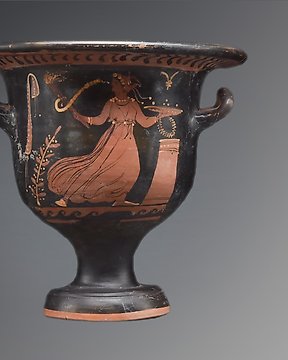
Antik grekiska, Magna Graecia Terrakotta Apuliens rödfigur Bell Krater. Med TL-test. Ca. 350-300 f.Kr - 24.5 cm
Nr 82386963

Nr 82386963

APULIAN RED-FIGURE TERRACOTTA BELL KRATER, ATTRIBUTED TO THE CHEVRON GROUP, H. 24,5 CM, D. 26,0 CM, APULIA, MAGNA GRAECIA, CIRCA 350-300 BC
Attributed to Chevron Group
With LT-Test from Ralf Kotalla Laboratory
ESTIMATE
€ 10,500,- to € 14,000,-
RESERVE INDICATION
€ 7,000,-
CULTURE
Greek, Apulia, Magna Graecia.
PERIOD
Circa 350-300 BC.
MEASUREMENTS
Circa 24,5 cm Height.
Circa 26,0 cm Diameter (top).
WEIGHT
Circa 1,3 Kg.
MATERIAL
Terracotta with polychrome paint.
CONDITION
Very fine condition with clear and fine painted decoration designs, minor ageing or chips visible on the surface. Reassembled from large original fragments. Some fragments in the vase restored, minor lacunae at the joins filled in and retouched. Finely restored on the break lines. The black polychrome and pigmentation virtually intact with minor restoration. Overall in very fine condition, as viewed.
PROVENANCE
With Yanto Alexander Fine Art, Netherlands, 2023 acquired London art market, 2023. From the private collection of a Somerset gentleman; previously in an old British collection, formed before 2000 on the United Kingdom / European art market. Acquired Belgium art market, collection formed over the past forty years, by decent acquired between 1965 to 1990`s-2000`s.
DESCRIPTION
A magnificent Greek large terracotta bell krater from Apulia, Attributed to Chevron Group. Executed in black slip with red figures and with details emphasized in white pigment. This rare Apulian Red-Figure Terracotta Bell Krater measures circa 24,5 cm height by circa 26,0 cm diameter. Apulia, Magna Graecia circa 350-300 BC. With LT-Test from Ralf Kotalla Laboratory.
The krater with disc foot, short stem, bulbous body and flaring lip, two ribbon-like handles are set bilaterally, beneath the rim is a chevron pattern.
The A side with a scene of a draped maenid wearing a stylised chiton fastened below her breasts by a belt with three white painted dots. Above the belt, the garment is bloused to form a kolpos. Her hair is covered by a kekryphalos. In her right outstretched hand is a thyrsus, in her left a patera with fingers holding a wreath. She stands over an alter or funerary monument.
On the reverse is a female head facing left. She wears saccos, hair ribbon, and stephane, as well as earring and necklace. On the left is a decorative vegetation.
CATALOGUE NOTES
This Apulian red-figure terracotta bell krater Attributed to Chevron Group. Apulia was a region of southern Italy that was famed for its glossy black glazed ware pottery and for its polychromatic decoration – often using shades of white, ochre and red. This type of vessel was used for sacred ceremonial purposes, rather than everyday tasks. Ceremonial pieces were often placed as offerings in tombs, thus their subject corresponds with the iconography of funerary rituals.
A krater was a large vessel, of Greek origin, used in Antiquity to water down wine. This was not done by virtue of frugal hosting techniques, but in fact Greek wine, in its undiluted form, was incredibly strong. It would normally be mixed with water at a ratio of one part wine to five or six parts water – consequently, a large vessel was needed for this purpose. To find out more about different types of Greek vessel please see our relevant blog post: Collecting Greek Vases.
REFERENCE
Attributed to Chevron Group
https://www.britishmuseum.org/collection/term/BIOG187145
https://artsandculture.google.com/asset/apulian-bell-krater-malibu-painter-chevron-group/FAH4qZ7VhHJzpA
See last pictures.
EXHIBITED
Important London Gallery; up to 2020 to 2023.
IMPORTANT INFORMATION
All Works of Art offered for sale are “Guaranteed to be Authentic" correspond to the given; Title, culture and period. The "Warranty of Authenticity" given is valid as long as you own the piece, only to the original purchaser and is not transferable to third parties. All sales transactions and online bids on our auctions are placed in person and are legally binding. All auction sales are final, no refunds, no exchanges, no cancellations possible.
Each artwork has been approved by Catawiki expert(s) after a thorough assessment of its authenticity and correct description, correspond to the given; Title, culture and period.
The seller will ship the item(s) within 3 days of receipt of payment confirmation. No export license is required for transport within the European Union for this lot. Due to the importance of this piece, an export license must be applied for once it is to be shipped outside the European Union. This is done through the Heritage Inspectorate of the Ministry of Education, Culture and Science. An export license is arranged after the final sale and can take up to 3 to 4 weeks.
The seller can prove that the lot was legally acquired. The seller guarantees that he has obtained this object legally and is authorized to sell it. Documentation seen by Catawiki. If you have any questions about a specific object, please send an e-mail via the Catawiki mail system. #yantoalexanderfineart
Hur du köper på Catawiki
1. Upptäck något speciellt
2. Lägg det högsta budet
3. Gör en säker betalning